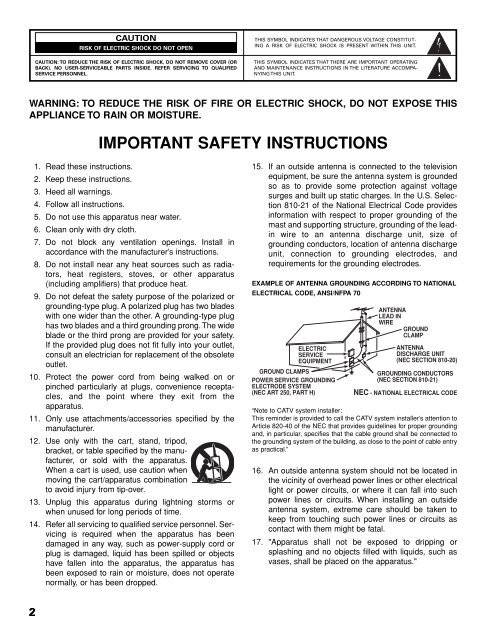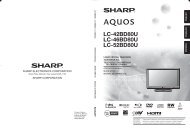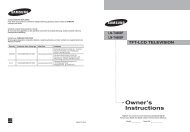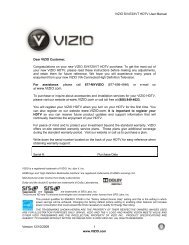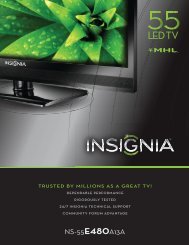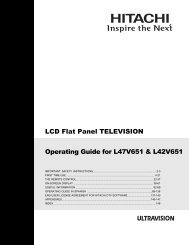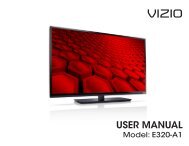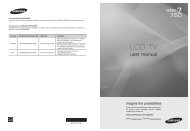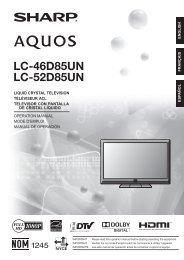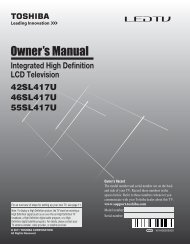Sanyo-DP42545 (English) - Specs and reviews at HDTV Review
Sanyo-DP42545 (English) - Specs and reviews at HDTV Review
Sanyo-DP42545 (English) - Specs and reviews at HDTV Review
You also want an ePaper? Increase the reach of your titles
YUMPU automatically turns print PDFs into web optimized ePapers that Google loves.
CAUTION<br />
RISK OF ELECTRIC SHOCK DO NOT OPEN<br />
CAUTION: TO REDUCE THE RISK OF ELECTRIC SHOCK, DO NOT REMOVE COVER (OR<br />
BACK). NO USER-SERVICEABLE PARTS INSIDE. REFER SERVICING TO QUALIFIED<br />
SERVICE PERSONNEL.<br />
THIS SYMBOL INDICATES THAT DANGEROUS VOLTAGE CONSTITUT-<br />
ING A RISK OF ELECTRIC SHOCK IS PRESENT WITHIN THIS UNIT.<br />
THIS SYMBOL INDICATES THAT THERE ARE IMPORTANT OPERATING<br />
AND MAINTENANCE INSTRUCTIONS IN THE LITERATURE ACCOMPA-<br />
NYING THIS UNIT.<br />
WARNING: TO REDUCE THE RISK OF FIRE OR ELECTRIC SHOCK, DO NOT EXPOSE THIS<br />
APPLIANCE TO RAIN OR MOISTURE.<br />
IMPORTANT SAFETY INSTRUCTIONS<br />
1. Read these instructions.<br />
2. Keep these instructions.<br />
3. Heed all warnings.<br />
4. Follow all instructions.<br />
5. Do not use this appar<strong>at</strong>us near w<strong>at</strong>er.<br />
6. Clean only with dry cloth.<br />
7. Do not block any ventil<strong>at</strong>ion openings. Install in<br />
accordance with the manufacturer’s instructions.<br />
8. Do not install near any he<strong>at</strong> sources such as radi<strong>at</strong>ors,<br />
he<strong>at</strong> registers, stoves, or other appar<strong>at</strong>us<br />
(including amplifiers) th<strong>at</strong> produce he<strong>at</strong>.<br />
9. Do not defe<strong>at</strong> the safety purpose of the polarized or<br />
grounding-type plug. A polarized plug has two blades<br />
with one wider than the other. A grounding-type plug<br />
has two blades <strong>and</strong> a third grounding prong. The wide<br />
blade or the third prong are provided for your safety.<br />
If the provided plug does not fit fully into your outlet,<br />
consult an electrician for replacement of the obsolete<br />
outlet.<br />
10. Protect the power cord from being walked on or<br />
pinched particularly <strong>at</strong> plugs, convenience receptacles,<br />
<strong>and</strong> the point where they exit from the<br />
appar<strong>at</strong>us.<br />
11. Only use <strong>at</strong>tachments/accessories specified by the<br />
manufacturer.<br />
12. Use only with the cart, st<strong>and</strong>, tripod,<br />
bracket, or table specified by the manufacturer,<br />
or sold with the appar<strong>at</strong>us.<br />
When a cart is used, use caution when<br />
moving the cart/appar<strong>at</strong>us combin<strong>at</strong>ion<br />
to avoid injury from tip-over.<br />
13. Unplug this appar<strong>at</strong>us during lightning storms or<br />
when unused for long periods of time.<br />
14. Refer all servicing to qualified service personnel. Servicing<br />
is required when the appar<strong>at</strong>us has been<br />
damaged in any way, such as power-supply cord or<br />
plug is damaged, liquid has been spilled or objects<br />
have fallen into the appar<strong>at</strong>us, the appar<strong>at</strong>us has<br />
been exposed to rain or moisture, does not oper<strong>at</strong>e<br />
normally, or has been dropped.<br />
15. If an outside antenna is connected to the television<br />
equipment, be sure the antenna system is grounded<br />
so as to provide some protection against voltage<br />
surges <strong>and</strong> built up st<strong>at</strong>ic charges. In the U.S. Selection<br />
810-21 of the N<strong>at</strong>ional Electrical Code provides<br />
inform<strong>at</strong>ion with respect to proper grounding of the<br />
mast <strong>and</strong> supporting structure, grounding of the leadin<br />
wire to an antenna discharge unit, size of<br />
grounding conductors, loc<strong>at</strong>ion of antenna discharge<br />
unit, connection to grounding electrodes, <strong>and</strong><br />
requirements for the grounding electrodes.<br />
EXAMPLE OF ANTENNA GROUNDING ACCORDING TO NATIONAL<br />
ELECTRICAL CODE, ANSI/NFPA 70<br />
ELECTRIC<br />
SERVICE<br />
EQUIPMENT<br />
GROUND CLAMPS<br />
POWER SERVICE GROUNDING<br />
ELECTRODE SYSTEM<br />
(NEC ART 250, PART H)<br />
ANTENNA<br />
LEAD IN<br />
WIRE<br />
GROUND<br />
CLAMP<br />
ANTENNA<br />
DISCHARGE UNIT<br />
(NEC SECTION 810-20)<br />
GROUNDING CONDUCTORS<br />
(NEC SECTION 810-21)<br />
NEC - NATIONAL ELECTRICAL CODE<br />
“Note to CATV system installer:<br />
This reminder is provided to call the CATV system installer’s <strong>at</strong>tention to<br />
Article 820-40 of the NEC th<strong>at</strong> provides guidelines for proper grounding<br />
<strong>and</strong>, in particular, specifies th<strong>at</strong> the cable ground shall be connected to<br />
the grounding system of the building, as close to the point of cable entry<br />
as practical.”<br />
16. An outside antenna system should not be loc<strong>at</strong>ed in<br />
the vicinity of overhead power lines or other electrical<br />
light or power circuits, or where it can fall into such<br />
power lines or circuits. When installing an outside<br />
antenna system, extreme care should be taken to<br />
keep from touching such power lines or circuits as<br />
contact with them might be f<strong>at</strong>al.<br />
17. "Appar<strong>at</strong>us shall not be exposed to dripping or<br />
splashing <strong>and</strong> no objects filled with liquids, such as<br />
vases, shall be placed on the appar<strong>at</strong>us."<br />
2


